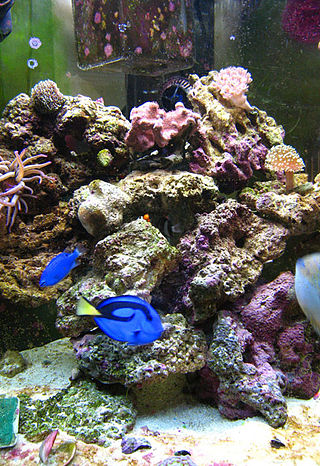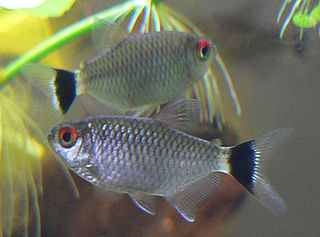
Aquarium fish feeders are electric or electronic devices that are designed to feed aquarium fish at regular intervals. They are often used to feed fish when the aquarist is on vacation or is too busy to maintain a regular feeding schedule. [1]

Aquarium fish feeders are electric or electronic devices that are designed to feed aquarium fish at regular intervals. They are often used to feed fish when the aquarist is on vacation or is too busy to maintain a regular feeding schedule. [1]
Fish feeders are usually clamped to the wall of the tank just over the water. Most designs consist of a hopper which is loaded with a variety of dry food, a timer which rotates the hopper at regular intervals (dispensing food in the process), and a method of setting the interval between feeding and the amount of food dispensed.[ citation needed ] Some designs have individual small hoppers. Whilst this limits the absolute number of feeds, it does allow for more accurate dosing, and delivery of mixed, (both flake and pellet), foodstuffs, which are often important for community tanks.
Most feeders can dispense flake, pellet, or freeze dried food. [2] [ better source needed ]
The benefits of electronic aquarium feeders are not only that the fish are fed when the aquarist is not at home, but they are also helpful in maintaining the fish' health. Because they are feeding small portions of food at scheduled intervals and precise feedings at appropriate times, the automatic feeders can be successfully used to feed diabetic fish. [3]
Another concern of aquarists is overeating. Fish are not to be given too much food. It is estimated that fish should be given as much as they can eat in 3 to 5 minutes, and once a day. However, the electronic fish feeders prevent overeating by releasing the right quantity of food, at scheduled times. This way, aquarists who have to get away for few days do not have to ask their neighbours or friends to come over and take care of their pets. It is often impossible to find a reliable person available and willing to do such a favor. The electronic fish feeders are therefore a solution for fish keepers who own aquariums and which ensure that the pets are fed in a healthy way and on schedule. There are multiple chambers within the electronic fish feeder when the feeder rotates (clockwise); the food is released at a set time. With the help of the feeder, feeding mixed food to the fish, including fish flakes and fish pellets, becomes more manageable. The mounting system is typically in the form of hooks or brackets. However, some electronic fish feeders also come with suction cups that attach to the wall of the aquarium. [4]
Another advantage of these devices is that electronic fish feeders may also be used to feed amphibians, if they are kept in glass cages. [5] [6]
There are also disadvantages that come with the electronic feeders. First, fish tend to get used to where and when the timer is going to trigger and food is going to fall which can create a feeding frenzy when the feeder drops the food. [7] This usually results in a lot of splashing which may wet the rest of the food. Mold can then grow and the leftover food is likely to go bad or to clog the feeder's mechanism. The humidity and moisture due to close proximity to the water can also cause this type of problem with an electronic feeder. Second, one has to make sure that the food containers are properly sealed and the food is kept fresh. At this time electronic feeders are not able to adjust to the changing needs of the fish over longer periods which may result in either overfeeding or underfeeding. Too much food in the water is not only bad for the fish, but also for their environment. [8]
The maintenance of electronic aquarium feeders basically consists in keeping the device clean and making sure the electronic part of the feeder does not get wet, which may cause improper functioning.[ citation needed ]
Though some feeders are designed specifically to keep food dry, many designs allow moisture to seep into the food hopper. This can cause clumping, and can result in the failure of the mechanism. Because fish feeders generally cannot feed frozen or live food, they are not effective options for feeding most predatory fish. [9] [10] Similarly, most (though not all), designs of feeder only allow for one type of food at a time, (flaked or granular), therefor fish communities requiring both floating and sinking foodstuffs are not well served, and may require two feeders.

Smoking is the process of flavoring, browning, cooking, or preserving food by exposing it to smoke from burning or smoldering material, most often wood. Meat, fish, and lapsang souchong tea are often smoked.

The neon tetra is a Freshwater fish of the characin family of order Characiformes. The type species of its genus, it is native to blackwater and clearwater streams in the Amazon basin of South America. Its bright colouring makes the fish visible to conspecifics in the dark blackwater streams, and is also the main reason for its popularity among freshwater fish hobbyists, with neon tetras being one of the most widely kept tropical fish in the world.

The black neon tetra is a freshwater fish of the characin family (Characidae) of the order Characiformes. It is native to the Paraguay basin of southern Brazil. They are often found in the aquarium trade.

A birdfeeder, bird table, or tray feeder is a device placed outdoors to supply bird food to birds. The success of a bird feeder in attracting birds depends upon its placement and the kinds of foods offered, as different species have different preferences.
Feeder may refer to:

Labidochromis caeruleus is a species of cichlid endemic to the central western coastal region of Lake Malawi in East Africa. It is also known as lemon yellow lab, the blue streak hap, the electric yellow or yellow prince, depending on the colour morph. A naturally occurring yellow-coloured variant from Lion's Cove is one of the most popular cichlids amongst aquarium hobbyists.

A reef aquarium or reef tank is a marine aquarium that prominently displays live corals and other marine invertebrates as well as fish that play a role in maintaining the tropical coral reef environment. A reef aquarium requires appropriately intense lighting, turbulent water movement, and more stable water chemistry than fish-only marine aquaria, and careful consideration is given to which reef animals are appropriate and compatible with each other.

A protein skimmer or foam fractionator is a device used to remove organic compounds such as food and waste particles from water. It is most commonly used in commercial applications like municipal water treatment facilities and public aquariums. Smaller protein skimmers are also used for filtration of home saltwater aquariums.

A marine aquarium is an aquarium that keeps marine plants and animals in a contained environment. Marine aquaria are further subdivided by hobbyists into fish only (FO), fish only with live rock (FOWLR), and reef aquaria. Fish only tanks often showcase large or aggressive marine fish species and generally rely on mechanical and chemical filtration. FOWLR and reef tanks use live rock, a material composed of coral skeletons harboring beneficial nitrogen waste metabolizing bacteria, as a means of more natural biological filtration.

Sterba's corydoras is a member of the South American Corydoras genus of freshwater aquarium catfish and one of the most popular species of Corydoras due to its attractive markings. The fish is native to the Guaporé River region between Bolivia and Brazil.

Fishkeeping is a popular hobby, practiced by aquarists, concerned with keeping fish in a home aquarium or garden pond. There is also a piscicultural fishkeeping industry, serving as a branch of agriculture.

Aquarium fish feed is plant or animal material intended for consumption by pet fish kept in aquariums or ponds. Fish foods normally contain macronutrients, trace elements and vitamins necessary to keep captive fish in good health. Approximately 80% of fishkeeping hobbyists feed their fish exclusively prepared foods that most commonly are produced in flake, pellet or tablet form. Pelleted forms, some of which sink rapidly, are often used for larger fish or bottom feeding species such as loaches or catfish. Some fish foods also contain additives such as sex hormones or beta carotene to artificially enhance the color of ornamental fish.

Feeder fish is the common name for certain types of small, inexpensive fish commonly fed as live food to other captive animals such as predatory fishes or carnivorous aquarium fish, turtles, crocodilians and other piscivores that naturally hunt in fresh, brackish or salt water ecosystems.

The Buenos Aires tetra is a tropical fish from South America. It was first observed in the wild in 1907, by Carl H. Eigenmann.

The diamond tetra is a small freshwater fish of the characin family of order Characiformes. It is found in and around Lake Valencia in Venezuela, South America.

The redeye tetra, is a species of tetra from the São Francisco, upper Paraná, Paraguay and Uruguay river basins in eastern and central South America. This freshwater fish is commonly kept in aquariums and bred in large numbers at commercial facilities in Eastern Europe and Asia. The redeye tetra is one of the more popular aquarium fish due to their schooling capability.

The snakeskin gourami is a species of gourami native to Southeast Asia. Prior to the merging of Belontidae to the family Osphronemidae, the snakeskin gourami was regarded as the largest member of its family. It is still the largest species in its genus and subfamily.

The Goldfish is a freshwater fish in the family Cyprinidae of order Cypriniformes. It is commonly kept as a pet in indoor aquariums, and is one of the most popular aquarium fish. Goldfish released into the wild have become an invasive pest in parts of North America.

An aquarium is a vivarium of any size having at least one transparent side in which aquatic plants or animals are kept and displayed. Fishkeepers use aquaria to keep fish, invertebrates, amphibians, aquatic reptiles, such as turtles, and aquatic plants. The term aquarium, coined by English naturalist Philip Henry Gosse, combines the Latin root aqua, meaning 'water', with the suffix -arium, meaning 'a place for relating to'.

The Costello tetra is a species of characin from the Amazon basin and is found in Brazil and Peru. The specific name comes from Lake Hyanuary in Brazil. Other common names used in English are January tetra and green neon. The name "green neon" is also used for Paracheirodon simulans.